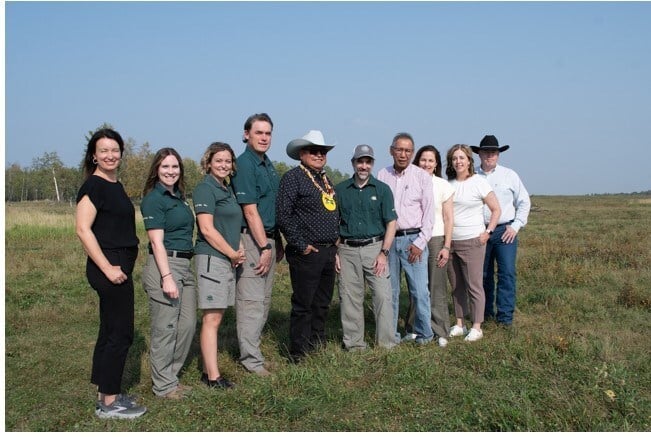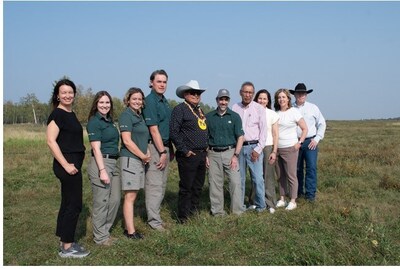Government of Canada supports Manitou Stone rematriation

Parks Canada and the Manitou Asinîy – Iniskim – Tsa Xani Centre exploring locations within Elk Island National Park for future cultural centre
FORT SASKATCHEWAN, AB, Oct. 2, 2025 /CNW/ – The cultures and identities of Indigenous peoples are rooted in the land, and honouring connections to place is an important element to reconciliation. Parks Canada works in partnership with Indigenous peoples in conserving natural and cultural heritage and sharing the stories of these treasured places.
Parks Canada and the Manitou Asinîy – Iniskim – Tsa Xani Centre (MAITX) have a signed Letter of Intent to collaboratively explore options to establish a permanent home for the Manitou Asinîy (the Manitou Stone) in Elk Island National Park, where it will remain under the care and custody of Indigenous Peoples.
On September 9, 2025, the Honourable Steven Guilbeault, Minister of Canadian Identity and Culture and Minister responsible for Official Languages met with representatives from MAITX, a First Nations-led not-for-profit, to confirm Parks Canada’s commitment to explore locations together within Elk Island National Park to house the Stone in a future cultural centre.
In keeping with existing Parks Canada regulations and laws under the Canada National Parks Act, MAITX will collaborate with Parks Canada to complete site assessments and environmental impact assessments. The results of these processes will inform the feasibility of the construction of a secured facility to house and honour the Stone. In the meantime, it will remain at the Royal Alberta Museum where it can continue to be cared for and accessible to Indigenous peoples.
Parks Canada is proud to support MAITX’s efforts to welcome Manitou Asinîy back into Indigenous care. As the home of two free-ranging bison herds, Elk Island National Park is uniquely positioned to support the reconnection of Indigenous peoples to Manitou Asinîy by returning this sacred stone to an area where buffalo still roam.
Quotes
“The Manitou Stone holds deep spiritual and cultural meaning for many Indigenous Nations, and its return to Indigenous care is a powerful act of healing and renewal. When I had the chance to see the Stone, I was deeply touched by its significance, and I am honoured to support the vision of the Manitou Asinîy – Iniskim – Tsa Xani Centre in establishing a permanent home for the Manitou Stone in Elk Island National Park. This is an important step toward restoring cultural connections and honouring Indigenous leadership.”
The Honourable Steven Guilbeault, Minister of Canadian Identity and Culture and Minister responsible for Official Languages
“The Manitou Asinîy-Iniskim-Tsa Xani Centre welcomes and values the willingness of Parks Canada, Elk Island National Park and the Federal Government to support our desire to return the Manitou Stone and to support the healing and education the Manitou Stone will bring to all people.”
Leonard Weasel Traveller
Chair, Manitou Asinîy-Iniskim-Tsa Xani Centre
“Alberta has been a national leader in repatriation for more than 20 years. I am proud to continue working with the Manitou Centre through our renewed Co-stewardship Agreement to return the sacred Manitou Stone to Indigenous care.”
Tanya Fir, Alberta Minister of Arts, Culture and Status of Women
Quick Facts
- Elk Island National Park was established in 1906 to protect one of the last large elk herds in the region and was the first wildlife refuge in Canada. Located just 35 minutes east of Edmonton, Elk Island National Park has drawn visitors to its natural setting and abundant wildlife for more than a century.
- Elk Island National Park is central to regional, national and international bison conservation efforts. The park reconnects plains and wood bison with the land and strengthens the global wellbeing of this iconic animal, renewing cultural, historical and ecological connections through its transfer program. A significant number of bison in Canada today are descended from the Elk Island herds.
- Parks Canada acknowledges the important relationship and caretaking between Indigenous people and bison. Elk Island National Park works closely with Indigenous nations and organizations to support the rematriation of bison to traditional territories.
- Manitou Asinîy, commonly called the Manitou Stone, is a 145-kilogram iron meteorite that fell on an unknown date many years ago. It is believed to have fallen near Hardisty, Alberta. The Stone is known by many names: Manitou Asinîy (Plains Cree – Creator’s Stone), awasis kohtakocihk kisikohk (Plains Cree- The Child Who Fell From the Sky), the Iron Stone, the Iron Creek Meteorite, and the Shining Rock are just a few. It is currently housed at the Royal Alberta Museum in Edmonton, Alberta under a co-stewardship agreement between The Manitou Asinîy – Iniskim – Tsa Xani and the Government of Alberta.
- The Manitou Asinîy – Iniskim – Tsa Xani Centre is a not-for-profit organization led by First Nations. It was formed to rematriate the Manitou Stone, a sacred meteorite that the Plains Tribes see as the living embodiment of the Creator.
Related Links
- The Manitou Asinîy – Iniskim – Tsa Xani Centre
- Bison Conservation in Elk Island National Park
- Manitou Asinîy (Royal Alberta Museum)
- Parks Canada mobile application
- Parks Canada website
SOURCE Parks Canada (HQ)


